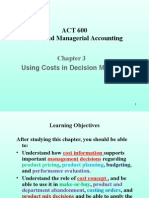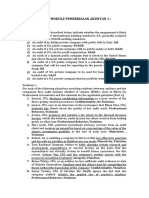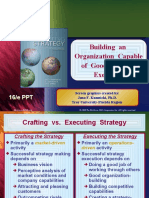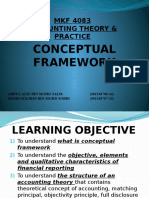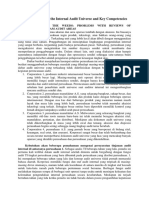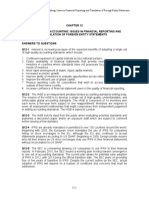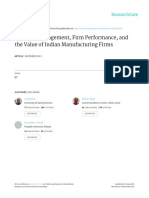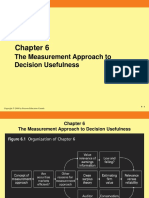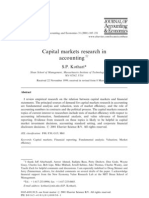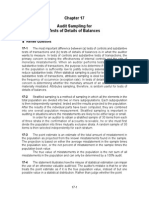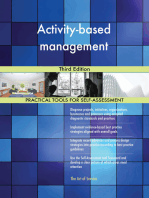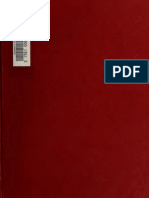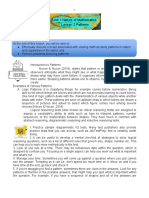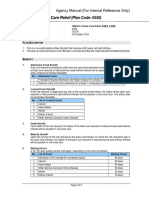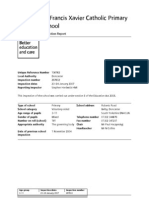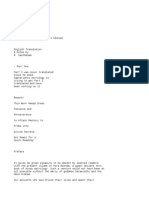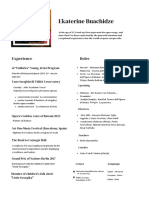Solutions Manual: Accounting Theory 7e
Solutions Manual: Accounting Theory 7e
Uploaded by
Tanisha SinghCopyright:
Available Formats
Solutions Manual: Accounting Theory 7e
Solutions Manual: Accounting Theory 7e
Uploaded by
Tanisha SinghOriginal Title
Copyright
Available Formats
Share this document
Did you find this document useful?
Is this content inappropriate?
Copyright:
Available Formats
Solutions Manual: Accounting Theory 7e
Solutions Manual: Accounting Theory 7e
Uploaded by
Tanisha SinghCopyright:
Available Formats
Solutions Manual
to accompany
Accounting Theory 7e
Prepared by
Ann Tarca
Chapter
Chapter 4
A conceptual framework
John Wiley & Sons Australia, Ltd 2010
Chapter 4: A conceptual framework
Chapter 4: A conceptual framework
THEORY IN ACTION
Theory in Action 4.1: IFRIC 3 and Emissions Trading
1. What would be the likely impact of the ‘mismatch’ arising under IFRIC 3?
The mismatch described in the article relates to (1) assets and liabilities and (2) recognition of
gains and losses on assets.
In relation to assets and liabilities the article implies that assets and liabilities are not
reognised to the same extent, e.g. more assets recognised than liabilities (or the reverse).
Therefore the balance sheet does not accurately reflect a company’s position in relation to
emissions trading. There is also a timing mismatch, with assets recognised when obtained and
liabilities when occurred.
In addition, there is also a mismatch is the treatment of gains and losses, possibly leading to
volatility in the income statement. Gains on assets are deferred (recognised in equity) while
losses are recognised immediately in the period incurred.
2. To what extent is ‘matching’ a principle proposed by the IASB Framework?
The Framework addresses (1) objectives of financial reports (2) qualitative characteristics of
the usefulness of information (3) definition, recognition and measurement of elements of
financial statements and (4) concepts of capital and capital maintenance (Paragraph 5). The
underlying assumptions are accrual basis and going concern (para 22-23). ‘Matching’ of
revenue and expenses is not required by the Framework although it is mentioned in para 95 as
a common accounting practice. In particular, para 95 states that matching not be used to create
assets and liabilities which do not meet the definitions of assets and liabilities under the
Framework. Para 95 states:
Expenses are recognised in the income statement on the basis of a direct
association between the costs incurred and the earning of specific items of
income. This process, commonly referred to as the matching of costs with
revenues, involves the simultaneous or combined recognition of revenues and
expenses that result directly and jointly from the same transactions or other
events. For example, the various components of expense making up the cost of
goods sold are recognised at the same time as the income derived from the sale
of the goods. However, the application of the matching concept under this
Framework does not allow the recognition of items in the balance sheet which
do not meet the definition of assets or liabilities.
3. In what ways can you see the influence of the IASB Framework on IFRIC 3?
If the Framework provides guidance to standard setters then we should observe that the
requirements of IFRIC 3 are consistent with the Framework. Therefore, we should observe
that IFRIC 3 meets the objective of financial reports (providing useful information for
decision making) and that the information provided under IFRIC 3 meets the qualitative
characteristics of financial reports (understandabilty, relevance, reliability and comparability,
© John Wiley and Sons Australia, Ltd 2010 4.2
Solution Manual to accompany Accounting Theory 7e
paragraphs 24-42). Further, the elements’ definition and recognition criteria should be
consistent with those in the Framework.
The discussion in the article does not suggest that IFRIC 3 was inconsistent with the
Framework. Further, it specifically states that measurement of assets and liabilities would
follow certain standards (IAS 38 for assets, IAS 37 for liabilities). However, the standards
themselves may not be consistent with the Framework. IAS 38 applies stricter conditions to
upward revaluation of intangible assets than are included for tangible assets under IAS 16 (the
condition that an active market exists) thus distinguishing between how tangible and
intangible assets are to be remeasured. This distinction is not made in the Framework. The
IAS 37 is a more recent standard and brings in ideas not in the Framework. For example, the
Framework refers to liabilities and provisions (paras 60-64) but not contingent liabilities. The
IAS 37 requires a present obligation to an external party before a provision can be recognised.
Some people would argue that this is not consistent with a principle of prudence, which is part
of the 1989 Framework (though likely to be removed in the revised framework).
4. In relation to IFRIC 3, do you consider that the IASB Framework provides a ‘theory
of accounting’ That is, does the Framework explain and predict accounting practice?
The Framework fails to provide a ‘theory of accounting’ in relation to IFRIC 3. The
Framework does not ‘explain and predict’ accounting practice. In fact, accounting practice
(by or more precisely, practising accountants) has (have) rejected accounting for carbon
trading as outlined by IFRIC 3. In Q3 we argued that IFRIC 3 recommendations were
generally consistent with the Framework. Yet practitioners have rejected IFRIC 3 suggesting
that the Framework is not effective in predicting how accounting will be carried out in
practice.
© John Wiley and Sons Australia, Ltd 2010 4.3
Chapter 4: A conceptual framework
Theory in Action 4.2 Principles vs rules: Lease Accounting
1. What are the criteria in IASB and FASB standards for classifying a lease as a
finance lease?
the lease transfers ownership to the lessee;
the lease contains a bargain purchase option to purchase that is expected to be
exercised;
the lease is for the major part of the economic life of the asset;
the present value of the minimum lease payments amounts to substantially all of the
fair value of the leased asset;
only the lessee can use the leased asset.
2. What is meant by ‘bright lines’ in accounting standards? Give examples of the
‘bright lines’ in US leasing standards.
‘Bright lines’ refers to the practice of standard setters of stating specific thresholds. Consider
for example the issue of materiality. IASB standard IAS 31 Materiality gives general
guidance about materiality without stating a specific threshold. For instance, para 9 states that
an item is material if its omission, misstatement or non-disclosure has the potential to
influence the economic decisions of users taken on the basis of a financial report or affect the
discharge of accountability by the management or governing body. Para 13 states that in
determining if an amount is materia, the amount is compared to the total of equity and the
appropriate asset or liability class total. In contrast, a bright line or specific threshold would
be to say that an item is material if it is 5% of the applicable asset or liability class total.
In relation to US GAAP leasing standard FAS 13, specific numbers are provided as follows:
Criteria (c) above: the lease is for the major part of the economic life of the asset (75%
threshold);
Criteria (d) above: the present value of the minimum lease payments amounts to substantially
all of the fair value of the leased asset (90% threshold).
© John Wiley and Sons Australia, Ltd 2010 4.4
Solution Manual to accompany Accounting Theory 7e
3. Mr Ketz does not believe the IASB approach of principles-based standards will be
effective for leases. Provide details of the arguments he presents in favour of his case
and consider the alternative view.
Ketz arguments Opposing arguments
Bright lines are arbitrary but they assist ‘Bright lines’ can be worked around,
preparers. principles are to be preferred.
The guidance is given by the standards Preparers have to make decisions about when
setters. rules for capitalisation are met and defend
Guidance should be given rather than left to these decisions to their auditors. Preparers
discretion of preparers. Decisions about should take responsibility for these
capitalisation are objective e.g. 75% judgements, not regulators.
threshold.
Without thresholds decisions about Managers can behave opportunistically in
capitalisation are subjective. Managers may relation to thresholds.
behave opportunistically.
Auditors cannot rebut managers decisions Auditors can rebut managers’ interpretations
about interpretation of leasing standards in relation to accounting standards. They
already do so in many areas and can do so in
relation to leasing.
4. Do accounting practices under current IASB leasing standards comply with the
definition and recognition criteria of the IASB Framework?
The IASB Framework definitions and recognition criteria are stated in the chapter. If
companies followed these definitions they would show all leases on the balances sheet
because:
The lease is an asset as (1) it relates to an item controlled by the entity (2) there is a past
transaction (the lease agreement) and (3) future economic benefits will flow from the
transaction (benefits from using the leased asset). Lease payments are a liability because (1)
there is a present obligation to an external party, the lessor (2) arising from a past event (the
lease agreement) (3) which will involve the outflow of future economic benefits (lease
payments).
In terms of recognition for both the asset and liability, (1) the amounts can be measured
reliably (as per the lease contract) and (2) future economic benefits are probable (the use of
the asset will generate net benefits, otherwise the contract would not have been entered into
by the company).
Thus current practice, where most leases are classified as operating under IAS 117, is not
consistent with the conceptual framework. Under the Framework criteria, leases would be
capitalised and assets and liabilities recognised in the balance sheet.
© John Wiley and Sons Australia, Ltd 2010 4.5
Chapter 4: A conceptual framework
Theory in Action 4.3 Guidelines for reporting ‘proforma’ earnings
1. According to the article, what is meant by ‘underlying profit’? How does
underlying profit differ from statutory profit?
Underlying profit is a profit figure derived from adjusting reported (statutory) profit for one-
off and unusual items. Statutory profit is derived based on accounting standards (‘strict
accounting rules’ in the article). Underlying profit is a ‘proforma’ profit measure. The
adjustments to get to underlying profit are subjective, that is, they are under the managers’
discretion. The article states that there is ‘greater opportunity for malleability in the
underlying profit figure’.
2. Why did the AICD and Finsia release guidelines about reporting underlying profit?
The voluntary guidelines provide seven principles which can be used to produce more
consistent reporting. Directors are encouraged to follow the principles so that investors and
users can understand the adjustments to statutory profit and can compare underlying profit
between entities. The guidelines are to ‘promote good reporting practice’ and to discourage
poor practices such as ‘inappropriate adjustments to statutory profits or window dressing’.
Issuing voluntary guidelines shows that the organisation wants to be influential in improving
the quality of reporting. Guidelines may also help members determine ‘best practice’ for
reporting. Issuing voluntary guidelines may also pre-empt (prevent) government intervention
through regulation.
3. According to the article, why do some directors consider that statutory profit is not
a ‘proper reflection’ of the underlying business? Explain whether you agree with the
directors’ view.
With the adoption of IFRS, new standards have been introduced and some accounting
methods changed. For example, there is more market value accounting (e.g. financial
instruments, share-based payments) and greater focus on impairment and write-downs of
goodwill. Directors may consider that these methods mean that the performance of the
underlying business is not properly reflected in statutory profit.
The directors’ view suggests that they disagree with the requirements of some accounting
standards. That is, they do not believe some accounting treatments measure position and
performance appropriately for prediction of future performance. For example, they may
disagree with the requirement to include unrealised gains and losses on certain financial
instruments. They may consider that the gains and losses are not part of operating profit, and
that the volatility introduced is misleading for analysts and investors. Restating statutory
profit (excluding the unrealised gains and losses) allows directors to present what they
consider to be ‘real’ (underlying, sustainable) profit of the entity.
4. Discuss whether the actions of (a) directors in releasing an underlying profit figure
and (b) the AICD/Finsia guidelines are supportive of the IASB/FASB’s conceptual
framework project.
The actions of the directors suggest that they do not support some requirements of accounting
standards and also some concepts of the Framework. Let us consider the example referred to
© John Wiley and Sons Australia, Ltd 2010 4.6
Solution Manual to accompany Accounting Theory 7e
in part three of the question (above), namely the recognition of unrealised gains and losses on
financial instruments in the income statement. This requirement comes from IAS 39 and is
also consistent with the Framework, which states that income includes revenue and gains
(para 74) and that expenses include losses and items which are unrealised (paras 78-80).
Therefore the directors do not appear to supportive of the underlying concepts of the
Framework and standards, at least in terms of them being performance measures that are
useful for evaluating the business and predicting future cash flows.
If the directors claimed that unreliability of measurement leads them to exclude items then
they are following the Framework. However, this argument is not persuasive, since the items
have been included in statutory profit. Presumably the firms’ auditors considered that they
could be measured with sufficient reliability.
The actions of AICD and Finsia in releasing guidelines are consistent with the Framework in
that the aim of the guidelines are to improve comparability and transparency and therefore the
quality of information provided. So while the information itself is ‘outside’ the Framework
and standards (that is, it is not consistent with either) the activity of issuing the
recommendations is actually supportive because it is consistent with the objectives of the
Framework (namely to produce high quality information which assists in decision making
process of users).
In terms of the current IASB/FASB project, the directors’ views may suggest that they will
have a particular opinion about measurement methods, i.e. a preference that unrealised gains
and losses not be included in income (in the profit and loss statement). If they feel strongly on
this issue, they may attempt to the discussion of measurement objectives and measurement
methods in the project to revise the Framework.
© John Wiley and Sons Australia, Ltd 2010 4.7
Chapter 4: A conceptual framework
CASE STUDIES
Case Study 4.1 BIG GAAP, SMALL GAAP: Accounting for SMEs
Under the four headings in the article, discuss the possible benefits of an SME standard
identified by the author. In your discussion, name the parties most likely to benefit from
the SME standard and explain the extent to which you agree or disagree with the views
presented by the author. You should also consider what factors may inhibit the success
of the SME standard.
1. Comparability of financial information
An SME standard will improve comparability within and between industries for private
entities, regardless of where a company is domiciled. Transactions and economic
circumstances will be accounted for and presented more consistently than under the present
various national requirements. Different recognition and valuation principles make it difficult
for users of financial statements to make informed decisions about a private entity’s
performance and cash flows. The SME standard has the potential to improve comparability of
information and the quality of communication with stakeholders, thus facilitating better
investment decision making.
2. Acquisitions, partnerships and cooperation agreements
The SME standard can assist with cross-border acquisition and partnerships or agreements
with foreign entities. It may simplify the sale of an entity because the financial statements,
which are fundamental in evaluating an acquisition and purchase price, are more transparent
and comparable. Evaluation of each entity is simpler and agreement is more likely. The
negotiation process is assisted by the use of common standards. Time and expense involved in
restating financial information is avoided and post-integration financial reporting costs are
lower.
3. Building relationships with overseas customers
The SME standard can assist private entities that are buying and selling goods across national
boundaries and those that seek to build new customer relationships. The IFRS for SMEs can
be used to promote a good image of the company i.e. that the company has high quality
financial reporting, and that it provides relevant information to assist customers’ decision
making. Financial statements are regularly demanded as part of the supplier selection and
evaluation process for a range of reasons, including assisting an assessment of solvency.
Companies that offer only national GAAP statements may be disadvantaged if their
statements are seen as less transparent and comparable than those of entities using IFRS.
4. Dealing with finance providers
Another positive effect from using IFRS is that the company may be in a better negotiating
position and be able to achieve a lower cost of borrowing. The positive image of IFRS (high
quality standards, that promote comparable and transparent information) may have a positive
effect on credit ratings. The more comprehensive disclosures in IFRS may assist lenders in
making a more accurate risk assessment, leading to a lower risk premium for the company.
© John Wiley and Sons Australia, Ltd 2010 4.8
Solution Manual to accompany Accounting Theory 7e
Use of IFRS may mean that the company can obtain new sources of equity finance because of
the greater transparency and comparability of information.
Overall, we can see that a range of parties may benefit from the adoption of IFRS for SMEs by
private entities. They include capital providers (investors and financiers) because they may
receive better quality information (more comparable, more transparent, more detailed) to use
in their decision making. Company managers can also benefit. They produce better quality
information which assists them in communicating will all outside stakeholders. The IFRS
reports assist them in a range of business operations. If the standards are useful for capital
raising and for operations then the business benefits and so too do managers, employees and
shareholders.
Of course, there are costs in adopting IFRS for SMEs. Companies incur costs of adopting the
new set of standards and in adjusting their accounting systems. Personnel must be trained in
use of IFRS. IFRS requirements are not necessarily straightforward, even within the IFRS for
SMEs standard. There may be confusion generated if accountants try to understand simplified
IFRS without reference to full IFRS. Staff will need to learn requirements and keep up to
date. The standards may require disclosures that the company has not previously made,
raising issues about proprietory information and the costs of disclosure.
The benefits of transparency and comparability can only be achieved if companies interpret
IFRS the same way and comply with all IFRS requirements (in the IFRS for SMEs). Private
companies may be subject to less rigorous auditing than large listed companies, thus they may
have more leeway in how they interpret and apply IFRS leading to differences between
companies. Private companies are subject to less oversight by enforcement bodies, so the
level of comparability may not be as high as for public companies that are closely scrutinised
by external regulators. Auditors are also faced with challenges. It is not yet clear the extent to
which they will be able to audit just to the SME standard and ignore requirements of full
IFRS.
Case Study 4.2: Usefulness of accounting information – Public sector and not-for-profit
entities
A model answer is not provided as students’ answers will vary according to the report
selected.
© John Wiley and Sons Australia, Ltd 2010 4.9
Chapter 4: A conceptual framework
Case Study 4.3 Revisiting the conceptual framework
1. Explain why principles-based standards require a conceptual framework.
The aim of principles-based standards is to build on previously agreed upon principles, which
do not have to debated each time when a standard is being developed. For example, if
definitions of elements are agreed upon, they can be used in standards and not debated again.
This approach aims to increase consistency among standards and to reduce time taken in their
formulation. Principle based standards rely on the existence of underlying principles which
can be used so that detailed rules do not have to be provided. The conceptual framework
provides a source of principles which can be used in accounting standards. For example, if the
conceptual framework provided an agreed approach to measurement e.g. measure all assets
and liabilities at fair value, then it would provide a principle which could be applied in
standards. The existence of a principle would make it easier and quicker to develop standards.
2. Why is it important that the IASB and FASB share a common conceptual
framework?
A study by the SEC has recommended that US standards be more principles based (see
discussion Chapter 4). Therefore, additional work on the principles underpinning the
standards, that is, the principles contained in the conceptual framework, is needed. The
IASB/FASB convergence project has created a need to converge the bodies’ conceptual
frameworks. Since standards are based on underlying conceptual frameworks, it is necessary
to converge the frameworks to achieve convergence of standards.
3. It is suggested that several parties can benefit from a conceptual framework. Do
you consider that a conceptual framework is more important for some parties
than others? Explain your reasoning.
Standard setters are the major beneficiary of a sound conceptual framework. It allows them to
develop their standards based on agreed upon principles. The article states that the IASB and
FASB base their accounting standards to a large part on the foundations of objectives,
characteristics, definitions, and criteria set forth in their respective conceptual frameworks.
Further, it states that principles-based standards must be rooted in fundamental concepts that
constitute a framework which is ‘sound, comprehensive and internally consistent’. Thus the
conceptual framework is important to achieving the goals of setting high quality accounting
standards and converging US GAAP and IFRS.
However, the conceptual framework can also be of assistance to preparers of financial
statements. It can provide guidance in relation to the interpretation of existing financial
statements and on matters which are not covered by existing standards. Auditors can also
benefit from the guidance in the framework in forming their opinions. Finally, the Framework
may assist users in interpreting the financial information provided.
4. What is meant by a ‘cross-cutting’ issue? Suggest some possible examples of
cross-cutting issues.
Cross cutting issues are those which relate to more than one standard. That is, the issue comes
up when various standards are being considered. Examples are the definition and recognition
criteria for assets, liabilities and equity. Revenue recognition matters and financial
instruments are other examples. In addition, measurement is a problem area. For example,
© John Wiley and Sons Australia, Ltd 2010 4.10
Solution Manual to accompany Accounting Theory 7e
standard setters have not found an obvious way to decide when to value items at historical
cost and when fair or market value should be used.
© John Wiley and Sons Australia, Ltd 2010 4.11
Chapter 4: A conceptual framework
QUESTIONS
1. How do conceptual frameworks of accounting attempt to create a theory of
accounting? Describe the components of the IASB Framework and how they
contribute to a theory of accounting.
Conceptual frameworks (such as those developed in the United States, Australia and at the
IASC/IASB) do not employ the term ‘theory’ because of the difficulty of demonstrating
logical consistency and in gathering empirical evidence to corroborate the theory. However,
by following a structured program of inter-related concepts, accounting regulators aim to use
the conceptual framework to achieve consistent accounting standards that will replace ad hoc
solutions to specific problems. In this context, the components of the conceptual framework
can be viewed as the building blocks of a theory of accounting.
The components of the IASB/Australian Framework are: objectives of financial statements;
qualitative characteristics of financial information (such as relevance, reliability,
comparability, timeliness and understandability); and definitions of the basic elements of
accounting reports (such as assets, liabilities, equity, revenue, expenses and profit) and
principles and rules of recognition and measurement of the basic elements, and the nature of
the information to be displayed in financial reports.
2. Some people argue that there is no need for a general theory of accounting, as
established in a conceptual framework. They argue that there is no overall theory of
physics, biology, botany or psychology, so there is no need for an overall theory of
accounting. Furthermore, attempts to develop an overall theory of accounting are
futile and unnecessary, since accounting has not needed a conceptual framework so
far. Debate this view.
It is true that in the physical sciences, there is no overall theory of a given field of study.
There is no theory of chemistry, or biology, etc. Some scientists have attempted to formulate
such theories, but have failed. It is generally agreed that such theories would be beneficial
because they would provide an integrated explanation of all aspects of the given field of
study. At present, different theories in a given discipline — for example, in biology — remain
as separate categories, and often the connection of one theory to another is not known.
Theories in the sciences are descriptive, but in accounting an overall theory would be
normative, telling accountants what ought to be done. This would be very useful if it could be
formulated. It would serve as a standard by which to judge practices. Although the probability
is slim that in the near future a logically consistent overall theory can be constructed, a
theoretical framework such as the conceptual framework can be helpful.
It is true that the profession has survived without a general theory, but a theory of some sort
has always been in mind. Constant reference to generally accepted accounting principles
reveals this. It would be easier to assess accounting practices and to formulate standards
consistent with each other if a general theory existed. If a theory is empirically verified,
accounting methods for particular purposes would also have empirical evidence to support
them. In other words, we would be able to present evidence as to why a certain procedure (for
example, FIFO inventory valuation) should be used rather than another method.
© John Wiley and Sons Australia, Ltd 2010 4.12
Solution Manual to accompany Accounting Theory 7e
3. What does the IASB Framework describe as the basic objective of accounting? What
are its implications?
Stewardship looks primarily to the past, asking the question: What happened? Decision
making looks to consequences in the future, asking the question: What will happen? A
decision-making approach sees accounting information as inputs for the decision-making
prediction models of users. If so, then we are concerned about what kind of accounting
information is relevant to decision makers. Some believe that current value is implied. Also
that statement of financial position accounts and their amounts are as important as those in the
income statement. Traditional accounting emphasises income.
4. What type of information do you think is useful for shareholders, lenders and
creditors? Is this the type of information that is currently provided?
Useful information is both relevant and reliable. Presumably, it is also ‘fair’.
Adopting a narrow perspective, useful information provides a basis for investors and creditors
to assess the amount, timing and uncertainty of future cash flows for themselves based on the
expected cash flows of the firm. Such a basis is provided by information concerning the
profitability and financial condition of the firm. In turn, this information is presently reported
in the statement of financial performance or the statement of financial position, and the
statement of changes in financial position. For the latter, many believe a cash flow statement
is especially pertinent.
Taking a broader view, useful information helps to efficiently allocate capital in the economy.
(Question 6 deals with this.)
5. The expressions ‘truth’, ‘justice’ and ‘fairness’ have all been applied to describe
desirable characteristics of accounting information. What role do you think they
play in practice? Are they included in the IASB Framework? If so, how? If not, why
not?
Truth, justice and fairness are socially desirable goals. Accountants should be concerned that
the information they report is true, just and fair. The audit opinion indicates a concern for the
above-stated goals. Useful information is relevant and reliable, and these latter terms
encompass the broader ones of truth, justice and fairness. However, we should understand that
what is true, just and fair often depends on who is making the judgement. The company may
believe that its financial statements meet the criteria of truth, justness and fairness, but the
shareholders may not think so. Accountants are often caught in the middle. This is all the
more reason why a general theory of accounting, especially one that is supported by evidence,
is important to accountants.
Students should be asked if the following procedures cause information to be ‘true, just and
fair’: LIFO inventory valuation; historical cost of land purchased 20 years ago.
© John Wiley and Sons Australia, Ltd 2010 4.13
Chapter 4: A conceptual framework
6. Explain the role of accounting in relation to:
(a) individuals
(b) firms
(c) the Australian economy.
Accounting information helps to efficiently allocate capital in the economy.
The successful operation of a free economy depends, to a large extent, on the good
judgements made by individuals about their investment opportunities and the investment
opportunities of firms. People need information to decide where to invest or lend, and at what
price.
In relation to firms, accounting information forms the basis for many contracts, such as debt
contracts that include covenants specifying that the firm will not allow its leverage ratio to
exceed a certain level, or management compensation plans that provide managers with
bonuses based on reported corporate earnings. As such, the firm’s cash flows are tied to
accounting numbers. Since the value of the firm is the present value of all future cash flows
and those cash flows are tied to accounting numbers, accounting numbers determine the value
of the firm.
In relation to the economy, accounting information plays a vital role in the equitable
allocation of capital, and it contributes to the effective performance of the price system. The
effective operation of our economy means that efficient and inefficient companies must be
identified, so that resources are channelled to the former and away from the latter in order to
have a ‘successful’ economic system. What would happen, after a long period of time, if
‘incorrect’ information is reported? The economic system would become inefficient (because
of the existence of many inefficient firms), causing serious economic problems to all.
7. Can accounting ever provide an unbiased map of economic reality? Why or why
not?
Yes. Criticisms of neutrality or freedom from bias take two forms. First, some argue it is a
state of mind that is not attainable, because all of us are affected by personal values that have
been shaped by our particular beliefs, traditions, environment, background and personality.
Granted that this is true, it is still meaningful to speak of neutrality or freedom from bias. We
recognise the existence of these influences on our perceptions. The idea is to control them
within an acceptable range.
Second, some contend that neutrality or freedom from bias is not operational, because we
cannot be expected to read other people’s minds. However, it is possible to translate neutrality
or freedom from bias into operational terms by establishing specific control devices that are
external and subject to examination.
Control devices are the means by which the notion of objectivity receives operational
meaning. Control devices have to do with making public or external what is essentially
internal or introspective. Rules and procedures under the heading of disclosure, consistency,
comparability, and materiality as well as GAAP are practical control devices.
In the accounting literature, practical control devices under the heading of objectivity have
taken the following three forms:
© John Wiley and Sons Australia, Ltd 2010 4.14
Solution Manual to accompany Accounting Theory 7e
to make specific and precise the concepts and procedures of accounting, and to obtain
general agreement on them
to determine a consensus of the measure among a number of experts
to improve the standards of competence and ethics of the profession.
Accountants must construct unbiased or neutral financial maps of economic reality.
Otherwise, as Solomons warns, ‘If it ever became accepted that accounting might be used to
achieve other than purely measurement ends, faith in it would be destroyed’.
8. Some argue that the development of a conceptual framework is inappropriate
because accountants constantly deal with specific issues that will not be envisaged by
an overall, general conceptual framework. In particular, a conceptual framework
makes no allowance for differences in the social contexts where accounting is
applied. They also argue that it would be preferable to develop case-specific solutions
to accounting issues, based on case study research, and bearing in mind the social
contexts of all accounting decisions. Discuss this view, presenting arguments for and
against it.
Determining ‘best’ accounting methods for situation-specific problems can be accomplished
in a more systematic and consistent manner if there exists an underlying theory to guide
solutions to problems.
In the absence of an overall theory, the results of a micro or case study approach cannot be
generalised to other situations. There is also the possibility that the same or a similar problem
might be solved in an entirely different and contradictory manner if there is no overall theory
or set of generally accepted principles to restrict the ad hoc subjectivity of the decision maker.
The results of case studies can, however, be used as empirical evidence in constructing a
theory of accounting.
9. What is the difference between art and science? Is accounting an art or a science?
Does it matter? Why or why not?
Whether accounting is an art or a science has long been debated by accounting academics
without coming to an agreement. One position in the middle of the two extremes is that
accounting theory is a science whereas accounting practice is an art. According to Sterling,
there is nothing inherently unscientific in accounting. In fact it is the approach adopted by the
researchers in a discipline that makes the discipline scientific or otherwise.
Accountants who believe in the scientific approach seek empirical evidence to support
accounting practices so that practitioners can recommend the most appropriate methods for
given situations based on the evidence. The scientific approach in accounting is not an attempt
to make scientists of practitioners, nor is it an attempt to discuss ‘absolute truths’, since there
are no absolute truths in science.
Looking at the research in accounting, particularly during the last 30 years, one can see a
great deal of analytical as well as empirical research; both being integral parts of a scientific
theory. It is therefore inappropriate to claim that accounting is in the pre-science stage.
© John Wiley and Sons Australia, Ltd 2010 4.15
Chapter 4: A conceptual framework
10. ‘The development of a SME standard by the IASB will defeat the purpose of
international harmonisation.’ Explain why you agree or disagree with this statement.
The rationale for international harmonisation of accounting is as follows: If companies use the
same set of accounting standards, there will be greater transparency and comparability
between financial reporting from companies from different countries, thus assisting
international investors in efficient allocation of resources and leading to a reduced cost of
capital for companies. In addition, companies will not be forced to meet the cost of using
more than one set of national GAAP.
These advantages are important for many companies in different countries, hence the global
support for international harmonisation. However, they are not important for all companies.
For example, smaller less international companies may find the arguments less persuasive.
Smaller companies may not have international activities and investors, and therefore do not
benefit from the use of international standards.
Smaller companies may argue that they do not need to use the full IASB standards because
they do not have users who are dependent on the financial statements for information, or who
need internationally comparable information.
The use of an SME standard does mean that all companies are not complying with full IASB
standards, so comparability is reduced. However, if SME companies do not have international
operations and investors, it is not a disadvantage that they do not comply with the full set of
international standards. Thus an SME standard does not defeat the purpose of international
harmonisation.
11. In Australia, the conceptual framework did not proceed to SAC 5 concerning
measurement.
(a) Why do you think that is the case?
(b) Do you think that accounting standards have been moving towards a particular
measurement method? If so, what is that method?
(c) How can standards lead the development of a formalised conceptual framework?
(a) SAC 4 was highly controversial. SAC 5, dealing with measurement, would be even more
controversial. As such, it is fair to say that at the time the AASB felt that the business
community was not ready to accept a standard prescribing measurement methods.
Furthermore, while the majority of the AASB might agree on a particular general
approach to measurement (for example, current market values) it is likely that the AASB
would have great difficulty obtaining agreement on more specific issues (such as how to
treat transactions costs, discounts, etc.). It was deemed prudent to defer development of
SAC 5 until the community was more supporting. Following adoption of IFRS, standards
on measurement come from the IASB.
(b) Increasingly, accounting standards have been requiring use of net market values, which
are current market selling prices less transactions costs. Some regard this as a ‘back-door’
way of introducing fair value measurement requirements.
(c) Standards can contribute to the development of a formalised conceptual framework. If
they introduce concepts or methods that become more accepted once they are prescribed
in an accounting standard, this provides a lead-in to a more general document such as a
Statement of Accounting Concepts for the conceptual framework. For example, the more
© John Wiley and Sons Australia, Ltd 2010 4.16
Solution Manual to accompany Accounting Theory 7e
standards require measurement at net market value or disclosures of net market values, the
more acceptable the method becomes, and the easier it is likely to be to gain general
acceptance of a Statement of Accounting Concepts that requires measurement at net
market values.
12. Give reasons for your answers to the following questions.
(a) How important is it that standard setters agree on objectives, concepts and
definitions before they develop a conceptual framework of accounting?
(b) How important is it that the conceptual framework is generally accepted by the
business community before it is applied to develop accounting standards?
Although it is important that prior agreement be reached on concepts and definitions in the
conceptual framework programs so that there is no confusion in understanding the subject
matter, one must remember that substantive knowledge comes from investigation of the
subject matter, not from prior agreement on definitions. We should take care that statements
we make should never depend on the meaning of our terms. Unfortunately, this is not the
approach of the conceptual framework projects. For example, when the standard setters define
‘assets’, ‘liabilities’ and so on, they intend that the valuation decisions should depend on the
definitions. Similarly, prior agreement on the objective of financial reporting may be biased
towards a particular valuation system.
(c) Why do the FASB and IASB require a common conceptual framework.
See discussion in the chapter. The FASB and IASB have embarked on a convergence project,
to remove differences between their respective standards and to align their work agendas. The
standards produced by both bodies should reflect the underlying principles contained in their
conceptual frameworks. For example, the financial statements elements (assets, liabilities,
equity, income and expenses) are defined in conceptual framework and these definitions are
used in standards. If the IASB and FASB have differences in their frameworks, they could
flow through to differences in their standards. Thus, agreement about fundamental matters
such as definitions and recognition criteria can help the boards to produce harmonised
standards.
13. Explain the advantages and disadvantages of principle-based and rule-based
standards.
The focus of principle based standards is on an underlying principle or principles. They
require that the principle be interpreted by financial statement preparers and auditors. They do
not set out what preparers are to do in a step by step manner. Rather, they provide guidance to
be interpreted and applied in an appropriate manner. They are more flexible, as they allow
companies to apply the principles in a way that is appropriate for their situation and business,
in order to convey useful information for decision making.
Rule-based standards include detailed directions about actions required by preparers. They are
more specific than principle-based standards, and may include ‘bright line’ thresholds such as
“greater than 50%”. Rule based standards tend to be longer and more complicated, with more
amendments, as standard setters try to cover all situations in which the rules apply.
© John Wiley and Sons Australia, Ltd 2010 4.17
Chapter 4: A conceptual framework
Specific rules are easier to follow and enforce so are favoured by some preparers, auditors and
regulators. However, one problem with rule based standards is that rules can be “worked
around” to give a result which is technically in compliance with the rules but does not meet
the overarching objective of the standard (the substance over form debate). It is possible to
comply with the substance of a rule based standard while not complying with its form. For
example, leases which are in substance finance leases are structured to meet the tests for
operating leases so that they can be shown as operating rather than financial leases in the
financial statements.
14. Why has the FASB been directed to produce more principle based standards? Do
you consider this to be a realistic standard setting objective?
Some corporate collapses in the United States have involved the abuse of accounting
standards. For example, the collapse of Enron in 2001 showed how the company’s managers
and auditors created special purpose entities which would not have to be consolidated under
existing accounting standards. The managers and auditors were working around the rules
contained in US GAAP. Their actions breached the underlying principle consolidation, that is,
that entities under control of a parent entity be included in the consolidated financial
statements.
The abuse of accounting standards in this way, that is, specifically working around the rules,
brought attention to the rule-based nature of US GAAP. As a way of improving financial
reporting and preventing events like Enron in the future, it was recommended that US GAAP
be more principles-based. The idea is that principles are more difficult to work around than
rules and will therefore be less open to exploitation. The SEC has recommended and the
FASB has accepted that it should pursue a more principles-based approach (described as
objectives based) because of the extent of financial havoc following Enron.
In theory, the objective of producing principles based standards is a reasonable one. It is the
approach taken by the IASB. Because of the advantages of principles-based standards, it is a
reasonable objective. In practice however, producing principles-based standards is
complicated by two issues. First, if principles are unacceptable e.g. measure all financial
instruments at market value, then the principle may get reduced by the application of specific
rules e.g. measure available-for-sale securities at market value. Second, preparers seek
guidance in the form of rules to assist them to comply with standards. In cases where these
issues are affecting the standard setting process, it may be impossible for the standard setter to
produce standards without rules. However, the changed focus in US standard setting should
result in more use of principles and less use of rules in standards.
© John Wiley and Sons Australia, Ltd 2010 4.18
Solution Manual to accompany Accounting Theory 7e
15. Discuss whether the IASB Framework is merely a policy document based on
professional values and self-interest, without scientific foundation. In your
discussion, state your opinion on whether the conceptual framework should serve as
a policy document in this manner.
This question covers the last part of the chapter under the heading ‘Professional values and
self-preservation’. Students can expand on the following major points:
Accountants have a special status in the society. In Australia this is witnessed by the
Royal Charter endowed on the Institute of Chartered Accountants, the profile associated
with the CPA program of CPA Australia and the professional monopoly by the major
accounting bodies.
The ability of the accounting profession to retain legitimacy as a profession will be judged
by society, in terms of the apparent coherence and theoretical defensibility of the
profession’s body of knowledge; hence the need for a conceptual framework (Hines,
1989).
The conceptual framework plays a vital political role in maintaining self-regulation and in
lobbying against increased regulation by government bodies.
A conceptual framework program alleviates the criticism of the diversity of accounting
standards — a major threat to the profession’s loss of control of the standard-setting
process.
The conceptual framework project is not about setting rules for accounting practice;
rather, it is about legitimising the process of accounting practice.
16. Assume that you have been contracted by the Australian Accounting Standards
Board to develop a proposal regarding whether to issue an accounting standard on
accounting for the costs of environmental damage. Draft a proposal of 1500 words or
less outlining why you think it is appropriate, or inappropriate, to develop an
accounting standard on this issue. Also outline the key issues that would need to be
covered by the standard and how the conceptual framework can contribute to
resolution of those issues.
The purpose of this question is that the students should be able to apply what they have learnt
from the conceptual framework project and other readings to the general issue of standard
setting. The best way to approach the question is to address the following key points:
alternative approaches to standard setting
the scope of the proposed standard
reference to academic accounting research
potential benefits or drawbacks of the standard.
Students could begin with a classification of various approaches to an accounting theory:
empirical inductive approach
the deductive approach (true income, user needs, information economics)
new empiricism.
They could then discuss the implications of these approaches for the standard setting bodies
— for example, problems (or impossibility) of measuring true income; economic
consequences of accounting standards; and the political nature of the standard setting process.
This should then lead into a discussion of the topic itself:
© John Wiley and Sons Australia, Ltd 2010 4.19
Chapter 4: A conceptual framework
What is meant by the ‘costs of pollution’? What type of pollution are we talking about:
air, water, noise? Does costs mean costs actually incurred by the company to avoid
polluting the environment, or is it a valuation of the pollution costs to the company/society
through the company’s operations? How can one measure these costs?
The subject matter is important as it has clear implications for the scope of the proposed
standard. Is it to be a valuation standard (requiring auditors to check the company’s
valuation of pollution costs) or is it a disclosure standard (requiring the company to
disclose fines or reports by inspectors, etc.)? Students should include some comments on
the past success of the standard-setting bodies on inflation accounting, research and
development expenditure and other relevant issues.
This will eventually follow into a discussion about the political nature of the accounting
standard-setting process. Does the standard-setting body have enough power to set such a
standard? Will the powerful lobby groups frustrate any change? What is the benefit of
loosely worded, vague and subjective standards? Would the standard achieve anything or
is it just an exercise to show that something is being done so that the accounting
profession’s self-regulation is not threatened?
17. Write a report of 1500 words or less to the chairpersons of the Financial Reporting
Council and the Australian Accounting Standards Board, commenting on the
following argument:
Attempts to bring about radical change through the introduction of a conceptual
framework have failed. When it appeared as though SAC 4 would require firms
to report a greater number of liabilities, lobbying began in earnest and business
ensured that any innovation was quashed. As such, the best that can be hoped for
from a conceptual framework is that it legitimises current practice, maintains
existing social and economic status, and staves off public sector attempts to
control accounting standard setting.
This question covers the whole chapter. In addition to the answer to question 7, students
should summarise the scientific criticisms levelled at the conceptual framework projects, and
should also cover the material under the heading ‘The conceptual framework as a policy
document’. In their answer, students should discuss the following points:
The purpose of the conceptual framework was that prior agreement on fundamental terms
would minimise inconsistencies. SFAC No. 5 states that concepts are to be developed as
the standard-setting process evolves. The question is: How can a conceptual framework
guide choices from among alternative principles and rules if the elements of the
framework are defined in those very same terms? (Dopuch and Sunder)
Definitions are general and vague.
Recognition criteria are couched in terms of (subjective) probabilities.
The measurement problem is open-ended.
Contrary to Popper, the FASB sought for the definitions to bear as much weight as
possible (Gerboth). This is true, also, of SAC 4’s role in Australia.
Ontological assumption. The conceptual framework adopts an economic realism–
measurement approach. According to Hines, ‘we communicate constructed reality’.
Hence, can we provide information that is neutral, independent and free from bias?
Demski’s impossibility theorem
Epistemological assumption:
– scientific truth has no absolute truth (Feyerabend).
– accounting researchers believe in a (confused) notion of empirical testability (Chua).
© John Wiley and Sons Australia, Ltd 2010 4.20
Solution Manual to accompany Accounting Theory 7e
Circularity of reasoning — for example, reliable information depends upon recognition
and recognition depends upon reliability.
Conceptual framework ignores findings from capital market research.
Conceptual framework is a policy document. According to Tinker, it is merely an attempt
to legitimise an ideological position at the theoretical level. Conceptual frameworks
appear to reinforce existing principles.
18. What is business risk auditing? How does it differ from traditional substantive
auditing? Why do critics believe it is used to justify selling more consulting services to
audit clients? How could business risk auditing be blamed for failures such as Enron?
Business risk auditing is a form of auditing that considers client risk as part of the audit
evidence process. Traditional substantive testing could be seen (simply) as based in
transaction and balance testing. That is, the auditor gathers evidence that transactions have
been correctly authorised, processed, and entered into the accounting records. Balances are
tested by gathering evidence, for example, on the physical (or legal) existence of the assets
and their correct measurement and depreciation allocations. In risk-based auditing auditors
focus on high risk areas, and gather evidence on the risk reducing properties of control
systems. They need to develop advanced understanding of business environments and
strategies. The differences between the two approaches include the focus on the client as
essentially a contained system in substantive auditing and an explicit consideration of the
external factors in business risk auditing.
© John Wiley and Sons Australia, Ltd 2010 4.21
You might also like
- Completing The Audit CH 11Document22 pagesCompleting The Audit CH 11Georgious ValentinoNo ratings yet
- ch12 Accounting Systems Solution ManualDocument8 pagesch12 Accounting Systems Solution ManualLindsey Clair RoyalNo ratings yet
- Chapter 8 263-270Document8 pagesChapter 8 263-270Anthon AqNo ratings yet
- Chapter 5Document8 pagesChapter 5Yusuf RaharjaNo ratings yet
- Psak 19Document8 pagesPsak 19Nadia NathaniaNo ratings yet
- ACT600 Chapter 3Document67 pagesACT600 Chapter 3Ali H. AyoubNo ratings yet
- Case Coso - The Boeing CompanyDocument11 pagesCase Coso - The Boeing CompanyTiaraju Mesquita100% (1)
- Job Interview Cheat Sheet V1.1Document3 pagesJob Interview Cheat Sheet V1.1-FedeCostas ツNo ratings yet
- 11.2.4.6 Lab - Securing Network DevicesDocument8 pages11.2.4.6 Lab - Securing Network DevicesasdfjklNo ratings yet
- Nicaragua Vs The United StatesDocument13 pagesNicaragua Vs The United Statesmayank kumarNo ratings yet
- Kunci Jawaban Module 1-4Document10 pagesKunci Jawaban Module 1-4meyyNo ratings yet
- Chap009 131230191204 Phpapp01Document41 pagesChap009 131230191204 Phpapp01AndrianMelmamBesyNo ratings yet
- Comprehensive Case-Campbell SoupDocument9 pagesComprehensive Case-Campbell SoupIlham Muhammad AkbarNo ratings yet
- Chapter15 LengkapDocument7 pagesChapter15 LengkapSulistyonoNo ratings yet
- Building An Organization Capable of Good Strategy ExecutionDocument22 pagesBuilding An Organization Capable of Good Strategy ExecutionAyi AhadiatNo ratings yet
- Scott Chapter 7Document4 pagesScott Chapter 7Maksi Reg ANo ratings yet
- Analisis Faktor-Faktor Yang Mempengaruhi Terjadinya Audit Delay PDFDocument17 pagesAnalisis Faktor-Faktor Yang Mempengaruhi Terjadinya Audit Delay PDFandrianyuniNo ratings yet
- Conceptual Framework: MKF 4083 Accounting Theory & PracticeDocument25 pagesConceptual Framework: MKF 4083 Accounting Theory & PracticeMohamad SolihinNo ratings yet
- Tugas 8-20 Kelompok 3Document4 pagesTugas 8-20 Kelompok 3Akuw AjahNo ratings yet
- 8 TA Normative - The Case of Conceptual Framework ProjectsDocument57 pages8 TA Normative - The Case of Conceptual Framework ProjectsArum SariNo ratings yet
- Lambeth Custom CabinetsDocument14 pagesLambeth Custom CabinetsHaider AliNo ratings yet
- Chapter 9 - Testing and Evaluation SystemsDocument16 pagesChapter 9 - Testing and Evaluation SystemsWiratama SusetiyoNo ratings yet
- CH 11 PDFDocument33 pagesCH 11 PDFRizal SyaifuddinNo ratings yet
- Teori Akuntansi - Chapter 2Document19 pagesTeori Akuntansi - Chapter 2angela.hoNo ratings yet
- Lambeth Case Study: Submitted byDocument6 pagesLambeth Case Study: Submitted byHaider AliNo ratings yet
- Auditing - Hook Chapter 9 SolutionsDocument12 pagesAuditing - Hook Chapter 9 SolutionsZenni T XinNo ratings yet
- RMK Incentive Plans - Kelompok 4Document12 pagesRMK Incentive Plans - Kelompok 4DannySaputra0% (1)
- Rangkuman TaDocument19 pagesRangkuman Tamutia rasyaNo ratings yet
- Changing Role of Management Accountant - CIMA v2Document13 pagesChanging Role of Management Accountant - CIMA v2Jason_Huan_2208No ratings yet
- Chapter ThreeDocument24 pagesChapter ThreeYeyNo ratings yet
- Universitas Pakuan: Fakultas Ekonomi Dan BisnisDocument2 pagesUniversitas Pakuan: Fakultas Ekonomi Dan BisnisLianurismudjayanaNo ratings yet
- Reaction Paper: Formula For Success: Target Costing For Cost Plus Pricing CompaniesDocument2 pagesReaction Paper: Formula For Success: Target Costing For Cost Plus Pricing Companiesdwi davisNo ratings yet
- Section - 5 Case-5.3Document7 pagesSection - 5 Case-5.3syafiraNo ratings yet
- Management Accounting Atkinson, Et - Al Chapter 9 Behavioral and Organizational Issues in Management Accounting and Control SystemsDocument13 pagesManagement Accounting Atkinson, Et - Al Chapter 9 Behavioral and Organizational Issues in Management Accounting and Control Systemsdenaaraa100% (1)
- On January 1 2014 Paxton Company Purchased A 70 InterestDocument1 pageOn January 1 2014 Paxton Company Purchased A 70 InterestMuhammad ShahidNo ratings yet
- Ch. 15: Managing The Internal Audit Universe and Key CompetenciesDocument10 pagesCh. 15: Managing The Internal Audit Universe and Key CompetenciesnabilahNo ratings yet
- ASDM Annual Report 2014Document240 pagesASDM Annual Report 2014Hilyatu Millati RusydiyahNo ratings yet
- Chapter 12 Solution ManualDocument68 pagesChapter 12 Solution ManualRiskaNo ratings yet
- Tugas 4Document2 pagesTugas 4Nisrina Nur Rachmayani100% (1)
- Chapter 6 - Internal ControlDocument36 pagesChapter 6 - Internal Controlsiti fatimatuzzahraNo ratings yet
- Chapter 17 Audits ReportDocument48 pagesChapter 17 Audits ReportShundei OtawaraNo ratings yet
- Tugas Kasus 1 - Sistem Informasi & PengendalianDocument9 pagesTugas Kasus 1 - Sistem Informasi & PengendalianHapsara SuryaNo ratings yet
- Kasus: Ex-Hr GMC GlobalDocument5 pagesKasus: Ex-Hr GMC GlobalMichelle Gabriella MarcNo ratings yet
- Case - Ohio Rubber Works Inc PDFDocument3 pagesCase - Ohio Rubber Works Inc PDFRaviSinghNo ratings yet
- Case Study: Colombo Frozen YogurtDocument3 pagesCase Study: Colombo Frozen YogurtandresuminhNo ratings yet
- CLEO - Annual Report - 2018 Dicetak Mulai Halaman 115-128Document196 pagesCLEO - Annual Report - 2018 Dicetak Mulai Halaman 115-128Dian AnjaniNo ratings yet
- Chapter 19 - Solution ManualDocument21 pagesChapter 19 - Solution Manualjuan100% (1)
- Managerial Accounting - 2Document2 pagesManagerial Accounting - 2Layla AfidatiNo ratings yet
- Earnings ManagementDocument14 pagesEarnings ManagementSalma ChakrounNo ratings yet
- The Measurement Approach To Decision UsefulnessDocument33 pagesThe Measurement Approach To Decision UsefulnessDiny Fariha ZakhirNo ratings yet
- Capital Markets Research in AccountingDocument127 pagesCapital Markets Research in Accountingcyann16No ratings yet
- Infosys Case AnalysisDocument13 pagesInfosys Case AnalysisPatrick Bien De JoseNo ratings yet
- Boynton SM Ch.20Document27 pagesBoynton SM Ch.20Eza R100% (2)
- Smokers Are Good For The Economy - ReallyDocument10 pagesSmokers Are Good For The Economy - ReallyUzma Siddiqui100% (1)
- Modern Auditing Beynton Solution Manual Chapter 1Document15 pagesModern Auditing Beynton Solution Manual Chapter 1Sjifa AuliaNo ratings yet
- Financial Accounting 1 by HaroldDocument450 pagesFinancial Accounting 1 by HaroldPeter KlaniNo ratings yet
- AEB14 SM CH17 v2Document31 pagesAEB14 SM CH17 v2RonLiu350% (1)
- CH 8 Palepu JW C PDFDocument14 pagesCH 8 Palepu JW C PDFcherry wineNo ratings yet
- The Size of Government: Measurement, Methodology and Official StatisticsFrom EverandThe Size of Government: Measurement, Methodology and Official StatisticsNo ratings yet
- IPSAS Explained: A Summary of International Public Sector Accounting StandardsFrom EverandIPSAS Explained: A Summary of International Public Sector Accounting StandardsNo ratings yet
- The Poetry of Julian Del CasalDocument496 pagesThe Poetry of Julian Del CasalDaniel Castañeda García0% (1)
- Measurement and Evaluation in Sport For Exit ExamDocument47 pagesMeasurement and Evaluation in Sport For Exit Exambirhanutebikew24No ratings yet
- Unit 1 Nature of Mathematics Lesson 2 PatternsDocument9 pagesUnit 1 Nature of Mathematics Lesson 2 PatternsChris Esterioso NotarionNo ratings yet
- Great Critical Care Relief GCCRDocument7 pagesGreat Critical Care Relief GCCRraathi_cdiNo ratings yet
- ST Francis Xavier Catholic Primary SchoolDocument11 pagesST Francis Xavier Catholic Primary SchoolxavierwebadminNo ratings yet
- USA Harvard MIT Mathematics Tournament 2014 139Document12 pagesUSA Harvard MIT Mathematics Tournament 2014 139Oki VnnNo ratings yet
- Confidential Report (Form II A)Document6 pagesConfidential Report (Form II A)Shiju P SNo ratings yet
- Mondejar v. Buban (A.m. No. MTJ-01-1349)Document2 pagesMondejar v. Buban (A.m. No. MTJ-01-1349)Rache GutierrezNo ratings yet
- Hora SaraDocument4 pagesHora SaraSaurabh Sharma100% (2)
- Assignment On Tech AbuseDocument4 pagesAssignment On Tech AbusesrinidhiNo ratings yet
- Assignment 4 Operation Management: Toyota MotorsDocument4 pagesAssignment 4 Operation Management: Toyota MotorsHamza MughalNo ratings yet
- Title Page: Running Head: How Poor Sleep Habits Impact University StudentsDocument8 pagesTitle Page: Running Head: How Poor Sleep Habits Impact University StudentsAdnan FarooqNo ratings yet
- TOPIC - Management of Challenged ChildrenDocument20 pagesTOPIC - Management of Challenged ChildrenDinesh Khinchi80% (5)
- Centralized Borrowing & Lending Platforms: Thematic InsightsDocument13 pagesCentralized Borrowing & Lending Platforms: Thematic InsightsAlan StivelmanNo ratings yet
- What Is Management Accounting and Its Functions?Document2 pagesWhat Is Management Accounting and Its Functions?ritu paudelNo ratings yet
- Srividya Kosa by RaoDocument2 pagesSrividya Kosa by RaoVashikaran.Org100% (1)
- Patch EnGBDocument467 pagesPatch EnGBTunsu George AlexandruNo ratings yet
- FIM-01-Nepalese Financial SystemDocument16 pagesFIM-01-Nepalese Financial Systemrajbikram100% (1)
- BARC TerminologiesDocument7 pagesBARC Terminologiesfirefox3011No ratings yet
- Syllabus AMST1510 Museum Collecting and Collections, Fall 2015Document9 pagesSyllabus AMST1510 Museum Collecting and Collections, Fall 2015Steven Lubar0% (1)
- Egon Schiele Paintings For ReproductionDocument268 pagesEgon Schiele Paintings For ReproductionPaintingZ100% (2)
- Lesson 1 Philosophical Perspective of The SelfDocument26 pagesLesson 1 Philosophical Perspective of The SelfJoseph PorteNo ratings yet
- Sect. 2-5: Motion at Constant AccelerationDocument15 pagesSect. 2-5: Motion at Constant AccelerationAditya GustiarahmanNo ratings yet
- Therapeutic Pediatric NutritionDocument2 pagesTherapeutic Pediatric NutritionAmna FaizNo ratings yet
- Ekaterine Buachidze CVDocument1 pageEkaterine Buachidze CVelenebuachidzeNo ratings yet
- United States v. James Bushert, 997 F.2d 1343, 11th Cir. (1993)Document20 pagesUnited States v. James Bushert, 997 F.2d 1343, 11th Cir. (1993)Scribd Government DocsNo ratings yet
- 8 Paper Edit Sheet 1Document4 pages8 Paper Edit Sheet 1api-476844264No ratings yet





